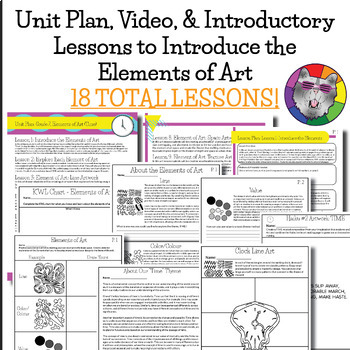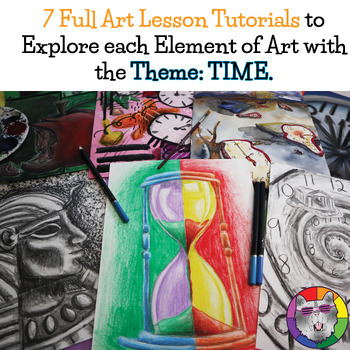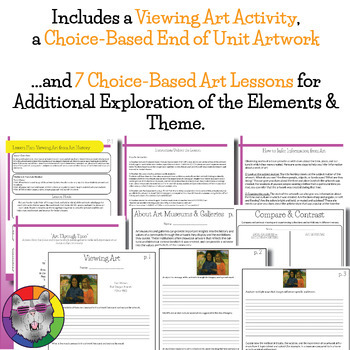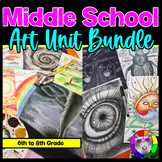7th Grade Art Lessons, Elements of Art Unit and Time Art Projects for Grade 7
- Zip
Also included in
- This is the BEST Middle School Art Curriculum, Art Project and Resource Bundle and it is the PERFECT way to Introduce the Elements of Art, Art History, and a Variety of Themes to your Students with Art Projects for each element, videos, themes and art activities. Not only are there FULL units for GrPrice $213.57Original Price $266.96Save $53.39
Description
Plan and Teach Art with a NO Prep, Fun, Ready-Made Grade 7, Elements of Art, COMPLETE Art Lesson Unit! This Elements of Art Unit introduces and teaches the Elements of Art and the Theme of this Unit with an introduction video and lesson activities, includes 7 Step-by-Step Art Tutorials for each Element, AND includes 7 Choice-Based Art Lessons to allow for experimentation and exploration-based, student-choice learning. This Grade 7 Art Unit teaches the Elements of Art through the theme: TIME for high engagement and increased student interest.
Do you want your Grade 7 students to make art, learn about the Elements of Art, and develop their drawing and art making skills? Are you short on time or are you looking to access a fully planned art unit that teaches the Elements of Art, includes full step-by-step art tutorials AND Choice-Based Art Lessons? Do you need a full video that you can play in your classroom to introduce the Elements of Art and the Theme of the Unit at an age-appropriate level? Are you looking for highly engaging, high interest art lessons to help you plan and be ready for teaching art like a pro no matter your art skills in minutes? This Art Resource is Ready for easy black-line printing!
♡A perfect solution for a busy teacher with a whole year to prep!♡
☛ Because this is a complete unit, it is also a wonderful program for Homeschool Families as a Homeschool Curriculum to follow as a grade specific guide.
☛SUBSCRIBE to my YouTube Channel and find FREE Resources
✂GET MORE Art Resources at MsArtastic.com
FOLLOW ME:
♡Instagram☛Facebook✂Pinterest✎Twitter
_________________________________
THIS GRADE 7 ELEMENTS OF ART RESOURCE INCLUDES:
*Fully-Planned, Non-Editable PDFs in a Folder
1) UNIT PLAN
-a unit plan to share the scope and sequence for this unit
2) 2 INTRODUCTION LESSONS TO THE ELEMENTS OF ART LESSONS
-1 Video in the folder that introduces the Elements of Art, Why Artists use them, and the theme of this unit: TIME
-2 Introductory Lessons with full lesson plans and worksheets to introduce the Elements of Art and practice drawing each element of art plus sheets to color and practice using the elements before they full artworks to scaffold learning.
3) 7 Fully-Planned Art Lesson Tutorial, 1 Artwork for Each Element of Art and in the theme: TIME
Each includes:
-Complete Lesson Plan with Lesson Hook, Participation Strategies, Steps for Instruction, and how to Conclude the Lesson
-Step-by-Step Tutorial for making the Artwork
-Includes Artwork Examples & Display Sign
-Rubric, Assessment, & Reflection
THE 7 FULL ART PROJECT TUTORIALS:
-Element of Art Line Artwork: In this art lesson students will be creating an artwork that explores time ticking away on a clock, using line to explore the concept of time and the movement of clock hands around the clock as time passes. Students will be exploring Soft Pastels on Construction paper in this artwork
-Element of Art Color/Colour Artwork: In this art lesson, students will be creating a hourglass artwork that focuses on using a warm color scheme and a cool color scheme using pencil crayons in each of the sections of the time artwork. There is also a poem included about time and color schemes to inspire and hook students on the lesson, but also integrate literacy into the art lesson. This is a great lesson for exploring pencil crayons/colored pencils.
-Element of Art Value Artwork: In this art lesson students will be creating Value artwork in the theme of “Passage of Time” with charcoal to explore the Element of Art Value. Students will follow a tutorial to draw the artwork and create a variety of values of with charcoal. This will be an artwork that focuses on exploring how a subject (such as architecture/fashion/technology/vehicles) has changed throughout time, and using charcoal to create a range of values and using value to make something seem farther in the past vs present.
-Element of Art Shape Artwork: In this art lesson students will be creating abstract clock artworks with a geometric and organic shapes to explore the Element of Art Shape. Students will follow a tutorial to create the artwork and will use oil pastel to draw organic and geometric shapes to create an abstract design. There is also an included article about both geometric shapes and organic shapes in relation to time to ignite learning and deepen knowledge on the elements and the theme.
-Element of Art Form Artwork: In this art lesson students will be creating an artwork that explores the different stages of an apple’s life, from seed to pollination, a fruit to decay- the different moments in time that an apple exists. Students will use oil pastels to develop a sense of form on a two-dimensional surface in each of the illustrations. Watercolor paint will be added at the end to complete the design.
-Element of Art Space Artwork: In this art lesson students will be creating an artwork of a landscape with melting clocks, and will use size, overlapping, and placement in relation to the horizon line and focal point as a strategy to explore the element of art space and create the illusion that melting clocks are closer to the viewer than others to create implied depth or the illusion of depth and space on a two-dimensional surface.
-Element of Art Texture Artwork: In this art lesson students will be creating an artwork inspired by the stone, Ancient Egyptian Relief Carvings and will be using graphite to explore creating value and texture of the smooth and rough areas of the carved stone. This is a great way to explore art from another period in time and to play with graphite as a medium for art making (graphite sticks preferable, but any type is fine).
4) 7 Choice-Based Art Projects to Explore the Elements of Art & the Theme: TIME.
There are 7 Choice-Based Art Lessons for each Element of Art. They have no example to allow students to develop their own choice, student-led concepts but allow them to play with mediums, techniques, and concepts to practice each of the Elements of Art. You may use or integrate them into the learning any time you would like either before a full art tutorial lesson to practice & play before they explore an element in depth OR use after to reinforce concepts and techniques learned and to allow for student-led investigations of ideas and skills.
Choice-based learning leads to student empowerment, higher engagement as they investigate their own ideas, and inspires students to want to learn new things. Choice in the classroom is linked to higher student effort and task completion which leads to more learning in the classroom. It also gives the learner a greater sense of control over their own ideas and interests and the ability to integrate their background and imagination. Choice-based learning allows students to grow at their own pace and investigate their ideas in addition to investigating concepts learned in class. Adding this allows students multiple ways to reach a learning objective.
Each includes:
-Complete Lesson Plan with Lesson Hook, Participation Strategies, Steps for Instruction, and how to Conclude the Lesson
-Planning, Rough Draft, Artwork pages
-Rubric, Reflection pages
-*no examples included as this is Choice-based learning and is teacher-guided and student-led learning for exploration & experimentation and creative freedom.
5) Viewing Art Lesson Activity
Students will learn how to, then view an artwork from art history and will use their critical thinking to identify Elements of Art in the artwork and consider the importance of viewing art. Students will listen to a poem and a reading about Art Galleries & Museums, and will learn about how to interpret art, how to determine a message in art, about mood and characteristics of form, and will assess, explain, and provide evidence of how museums or other venues reflect history and values of a community.
6) Choice-Based, End of Unit Art Project
Teacher will guide students through an End of Unit, choice-based artwork where students create an artwork that focuses on using two different Elements of Art and their theme, TIME, in the design. As a class, students will create student-led criteria for the artwork, then each student will develop their own artwork supported with the resources and their teacher. Students should also consider conveying mood and characteristics of form in their design.
_________________________________
NATIONAL ART STANDARDS THIS UNIT COVERS:
VA:Cr1.2.7a - Develop criteria to guide making a work of art or design to meet an identified goal.
VA:Cr1.1.7a - Apply methods to overcome creative blocks.
VA:Cr2.1.7a - Demonstrate persistence in developing skills with various materials, methods, and approaches in creating works of art or design.
VA:Cr2.3.7a - Apply visual organizational strategies to design and produce a work of art, design, or media that clearly communicates information or ideas.
VA:Cr3.1.7a - Reflect on and explain important information about personal artwork in an artist statement or another format.
VA:Pr4.1.7a - Compare and contrast how technologies have changed the way artwork is preserved, presented, and experienced.
VA:Pr6.1.7a - Compare and contrast viewing and experiencing collections and exhibitions in different venues.
VA:Re.7.1.7a - Explain how the method of display, the location, and the experience of an artwork influences how it is perceived and valued.
VA:Re.7.2.7a - Analyze multiple ways that images influence specific audiences.
VA:Re8.1.7a - Interpret art by analyzing art-making approaches, the characteristics of form and structure, relevant contextual information, subject matter, and use of media to identify ideas and mood conveyed.
VA:Cn11.1.7a - Analyze how response to art is influenced by understanding the time and place in which it was created, the available resources, and cultural uses.
_________________________________
HOW TO PREP:
-Review the Unit Plan to find the sequence for teaching the art lessons
-Start with the Introductory Art Lessons & Video
-Print your master copy and organize into a binder. Use the binder cover as the cover for the binder or the inside title page for a section in a binder.
-Photocopy student pages as necessary
-Use the binder as a quick reference for easy planning with simple or flexible art mediums
-Pick an Art Lesson & Teach
HOW TO USE:
-Follow each lesson plan as it specifically will tell you how to teach the lesson from the lesson hook, participation strategies, steps to teach, and conclusion.
-Print it off and keep it organized in a binder or a tub to make it easy to grab and teach!
-Photocopy student pages in advance & keep organized in folders for advanced, organized prepping.
*****************************************************************************
Customer Tips:
Be the first to know about my new discounts, freebies and product launches:
• Look for the green star next to my store logo and click it to become a follower. Voila! You will now receive email updates about this store. ☺
*****************************************************************************
Images and Lessons are Copyright Products to Ms Artastic & Artastic Collective
YOU MAY:
-Enjoy using this resource year-after-year with the students in your classroom
-Use this in creative ways! Explore and have as much fun with it as you would like
-Buy additional licensing for sharing with other teachers.
YOU MAY NOT:
-Use this on OutSchool
-Use this for your own commercial business (it should be used as a teaching resource for your classroom).
-Share the video on any PUBLIC website or blog such as YouTube/Vimeo or a classroom blog/website where anyone in the public can view it. This should be used for YOUR CLASSROOM only- no one else should see it. You, the owner can use it over and over.
-Put this your Blog or any other publicly accessed website where anyone can grab it.
-Share this product with other teachers, administration or districts. Admin can buy additional licensing to allow sharing.
-Sell this product or give it out for free or photocopy it for others.






